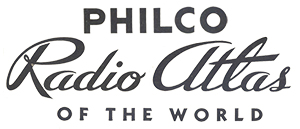|
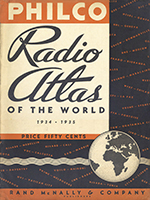 |
Philco Radio Atlas of the World, 1934-35 ed. This first atlas, like most of the others, is 20 pages long (including covers) and measures 13-1/2" high x 10" wide. It starts out with a world time chart, and then a list of the "Principal Short-Wave Stations of the World" broadcasting from 4.0 (HCJB) to 21.54 MHz. (W8XK, or KDKA), arranged by frequency. This information was supplied to Philco by the International Short Wave Club of East Liverpool, Ohio. Also contained in the atlas are two lists of North American stations, one for shortwave and one for "long-wave" (standard broadcast). There are similar lists, arranged by country, for other parts of the world, but covering shortwave only. For each part of the world there are also brief, paragraph-long writeups about the shortwave broadcasting from particular countries in that area, together with station-specific pictures. The maps, which are in color, are the most attractive part of the atlas. In this atlas there is a world map, plus maps for North and Central America, South America, Europe, Asia and Africa. These are Rand McNally maps, to which the names and locations of the world’s shortwave stations were added in red boxes connected by lines to the proper map locations. The advertising covers the "new 1935" Philco 16X, the Philco 16 Baby Grand, the Philco Model 144 Highboy, and the Philco 45C, 45 Lowboy, and Philco 66 Baby Grand. The outside rear cover has an ad for Philco high-efficiency tubes. |
|
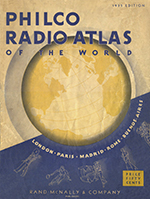 |
Philco Radio Atlas of the World, 1935 ed. From a quick look through this edition you might conclude that, save for the covers, it is exactly the same as the 1934-35 edition. But there are small changes to the station lists, the maps, and a few of the pictures accompanying the station writeups. A couple of different receivers are featured on the inside back cover, and the outside back cover highlights Philco receivers rather than Philco tubes. Otherwise, this edition is the same as the 1934-35 atlas. |
|
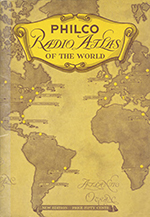 |
Philco Radio Atlas of the World, probably a second 1935 edition. This one is marked "New Edition," and it appears to be a second one from 1935, probably late in the year. Although the content retains the same general style as the earlier editions, the overall size is reduced to 10" high x 7" wide, and the pages expanded to 36 (including covers). The text is completely new. The booklet starts out with an airline mileage chart showing distances between various North American locations and major world cities; then a "Foreward" about shortwave reception; a list of "Principal Short-Wave Stations of the World" (still from the ISWC); brief writeups on shortwave broadcasters in individual countries, with new text and pictures; a Spanish alphabet pronunciation guide; a North American standard broadcast list; and promotion of a Philco project called the Radio Institute of the Audible Arts. The maps, now produced by J. W. Clement Co. of Buffalo, New York, are entirely new but retain the names and locations of many of the world’s shortwave stations. There is also promotion of Philco receivers; this edition features 1936 models, specifically the 660X, 610F, 630 Baby Grand, and the 116X. |
|
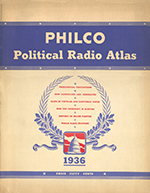 |
Philco Political Radio Atlas, first 1936 ed. This edition, now with the word “Political” in the title, returns to the 13-1/2” x 10” size. It was issued prior to the nominating conventions, which took place in June, and the content is more political than radio. There is information about the party conventions and how they are organized, and speculation about who the nominees might be. There are tally sheets for both conventions so you can keep track of the number of votes garnered by the nominees. There is an explanation of the process for electing the President, a map showing how many electoral votes each state had, histories of the Republican and Democratic parties, pictures of all the presidents, information on who is qualified to vote, and graphics showing the popular and electoral presidential vote counts from 1900 to 1932. The radio content is much reduced from earlier editions. There is a list of North American broadcast band stations and one of North American shortwavers; another list of the principal shortwave stations of the world, by frequency, and a one-page writeup about shortwave stations in general and the most often-heard countries. There is also a two-page colored world map, as in the 1935 edition, showing many of the world’s shortwave stations. The advertising on the inside front cover is for the Philco 625B and 116X Deluxe receivers, and on the inside back cover for Philco auto radios. |
|
 |
Philco Political Radio Atlas, second 1936 ed. This one, again 13-1/2” x 10”, was issued after the conventions but before the election, and most of the content is election related. There is an introduction, noting that "the next President of the United States will be elected by radio." Other political content is similar but not exactly the same as in the first 1936 edition: photos and writeups about the presidential and vice-presidential candidates (Roosevelt and Garner, Landon and Knox); the platforms of each party; information on state residency requirements and who can vote; the histories of the two major parties; pictures of the past presidents; etc. The radio content is likewise very similar to the first 1936 edition, with some items being identical and others very nearly so. The advertising inside the covers again features the Philco 116X Deluxe and Philco auto radios, while the outside back cover presents "the new 1937 Philco Foreign Tuning System," which was basically an improved bandspread. |
